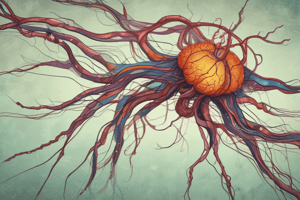Podcast
Questions and Answers
Norepinephrine and Epinephrine are classified as catecholamines.
Norepinephrine and Epinephrine are classified as catecholamines.
True (A)
The enzyme tyrosine hydroxylase is not involved in the biosynthesis of catecholamines.
The enzyme tyrosine hydroxylase is not involved in the biosynthesis of catecholamines.
False (B)
L-DOPA is formed from the decarboxylation of Norepinephrine.
L-DOPA is formed from the decarboxylation of Norepinephrine.
False (B)
Inhibitors of tyrosine hydroxylase can reduce levels of Norepinephrine in the brain.
Inhibitors of tyrosine hydroxylase can reduce levels of Norepinephrine in the brain.
The calculated log P of Epinephrine is positive, indicating it is non-polar.
The calculated log P of Epinephrine is positive, indicating it is non-polar.
Flashcards are hidden until you start studying
Study Notes
Adrenergic Neurotransmitters
- Norepinephrine (NE), Epinephrine (E), and Dopamine (DA) are catecholamines (CAs).
- Catecholamines are organic compounds containing a catechol nucleus (ortho-dihydroxybenzene) and an ethylamine group.
- Epinephrine is polar and soluble in water due to its three hydroxyl groups.
- Biosynthesis of Catecholamines
- Step 1: Tyrosine Hydroxylase (TH) catalyzes the hydroxylation of L-tyrosine to L-DOPA.
- TH requires molecular oxygen, Fe2+, and a tetrahydropteridine cofactor.
- TH is the rate-limiting step in CA biosynthesis.
- TH inhibitors include -methyl-p-tyrosine, -methyl-3-iodotyrosine, and -methyl-5-hydroxytryptophan.
- Step 2: L-aromatic amino acid decarboxylase (AADC) decarboxylates L-DOPA to dopamine.
- AADC is not specific to L-DOPA.
- Parkinsonism is characterized by dopamine deficiency in the brain.
- L-DOPA (levodopa) is a prodrug that enters the brain and is decarboxylated to dopamine.
- Peripheral AADC inhibitors like carbidopa can reduce systemic side effects of L-DOPA.
- Step 3: Dopamine β-hydroxylase (DBH) hydroxylates dopamine to norepinephrine.
- DBH is located inside vesicles.
- Dopamine is transported into vesicles by the vesicular monoamine transporter (VMAT).
- Step 4: Phenylethanolamine-N-methyltransferase (PENMT) catalyzes the N-methylation of norepinephrine to epinephrine.
- PENMT is a cytosolic enzyme.
- S-adenosyl methionine (SAM) is required as a methyl donor.
- Storage, Release, Uptake, and Metabolism
- Catecholamines are stored in vesicles.
- Release occurs through exocytosis triggered by nerve impulses.
- Reuptake into the presynaptic neuron is the primary mechanism of termination.
- Metabolism involves enzymatic breakdown to inactive metabolites.
Figure: Biosynthesis of Dopamine, Norepinephrine, and Epinephrine
- This figure visually represents the sequential steps involved in the synthesis of dopamine, norepinephrine, and epinephrine, highlighting the enzymes and substrates involved.
Figure: Model of Life Cycle of Norepinephrine
- This figure provides a schematic representation of the complete life cycle of norepinephrine, encompassing its synthesis, storage, release, reuptake, and metabolism.
Studying That Suits You
Use AI to generate personalized quizzes and flashcards to suit your learning preferences.




